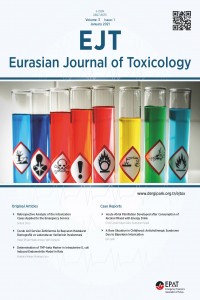Case Report
Year 2021,
Volume: 3 Issue: 1, 23 - 25, 30.03.2021
Abstract
Biperiden is an anticholinergic agent that acts on the central nervous system. It is used in the treatment of Parkinsonism and extrapyramidal symptoms. Anticholinergic syndrome develops in biperiden poisoning. Physostigmine is an effective central acetylcholinesterase inhibitor. In this article, we aimed to share our experience of using physostigmine in a case of central anticholinergic syndrome developing due to biperidene poisoning in a 4-year-old girl.
Keywords
References
- 1. Dose M, Tempel H. Abuse potential of anticholinergics. Pharmacopsychiatry, 2000; 33(Sup. 1):43-6. 2. Hammon K, DeMartino BK. Postoperative delirium secondary to atropine premedication. Anesth Prog, 1985;32:107–8. 3. Holzgrafe RE, Vondrell JJ, Mintz SM. Reversal of postoperative reactions to scopolamine with physostigmine. Anesth Analg, 1973; 52:921–5. 4. Kaiser Stadler M, Altmayer P. Central anticholinergic syndrome after propofol anesthesia. Anasthesiol Intensivmed Notfallmed Schmerzther, 1995; 30:116–7. 5. Schultz U, Idelberger R, Rossaint R, Buhre W. Central anticholinergic syndrome in a child undergoing circumcision. Acta Anaesthesiol Scand, 2002; 46:224–6. 6. Hagemann HD, Prass D, Hausdorfer J. A case of central anticholinergic syndrome in pediatric anesthesia.Anaesthesist, 1988; 37:193–5. 7. Holland MS. Central anticholinergic syndrome in a pediatric patient following transdermal scopolamine patch placement. Nurse Anesth, 1992;3:121–4. 8. Grace RF. Benztropine abuse and overdose case report and review. Adverse Drug React Toxicol Rev. 1997;16: 103-12. 9. Katsanoulas K, Papaioannou A, Fraidakis O, Michaloudis D. Undiagnosed central anticholinergic syndrome may lead to dangerous complications. Eur J Anaesthesiol, 2000; 17: 466-7. 10. Longo VG. Behavioral and electroencephalographic effects of atropine and related compounds. Pharmacol Rev, 1966;18:965–96. 11. Kulka PJ, Toker H, Heim J, Joist A, Jakschik J. Suspected Central Anticholinergic Syndrome in a 6-Week-Old Infant. Anesth Analg, 2004; 99:1376 –8. 12. Schneck HJ, Rupreht J. Central anticholinergic syndrome (CAS) in anesthesia and intensive care. Acta Anaesthesiol Belg, 1989:49: 219–28. 13. Hewer W, Biedert S. Delirium syndrome in biperiden poisoning. Fortschr Neurol Psychiatr, 1988;56: 133-6. 14. Köse R, Şahin ÖÖ, Abay E. Datura stramonium zehirlenmesine bağlı deliryum: Bir olgu. Anatolian Journal of Psychiatry, 2008;9: 54-7. 15. Duvoisin RC, Katz R. Reversal of central anticholinergic syndrome in man by physostigmine. JAMA, 1968:25: 1963–5. 16. Buchanan JF. Physostigmine as an antidote. Clin Toxicol Update, 1986;8:13-16. 17. Hartvig P, Wiklund L, Lindström B. Pharmacokinetics of physostigmine after intravenous, intramuscular and subcutaneous administration in surgical patients.Acta Anaesthesiol Scand, 1986:30: 177–82. 18. Lauven PM, Calaminus JM. Antagonists in anesthesia. Anaesthesiol Intensivmed Notfallmed Schmerzther, 1995:30: 331–6. 19. Watkins JW, Schwarz ES, Arroyo-Plasencia AM, Mullins ME; Toxicology Investigators Consortium investigators. The Use of Physostigmine by Toxicologists in Anticholinergic Toxicity. J Med Toxicol, 2015;11: 179-84. 20. Espi Martinez F, Espi Forcen F, Shapov A, Martinez Moya A. Biperiden dependence: case report and literature review. Case Rep Psychiatry, 2012;2012: 949256.
Year 2021,
Volume: 3 Issue: 1, 23 - 25, 30.03.2021
Abstract
Supporting Institution
yok
References
- 1. Dose M, Tempel H. Abuse potential of anticholinergics. Pharmacopsychiatry, 2000; 33(Sup. 1):43-6. 2. Hammon K, DeMartino BK. Postoperative delirium secondary to atropine premedication. Anesth Prog, 1985;32:107–8. 3. Holzgrafe RE, Vondrell JJ, Mintz SM. Reversal of postoperative reactions to scopolamine with physostigmine. Anesth Analg, 1973; 52:921–5. 4. Kaiser Stadler M, Altmayer P. Central anticholinergic syndrome after propofol anesthesia. Anasthesiol Intensivmed Notfallmed Schmerzther, 1995; 30:116–7. 5. Schultz U, Idelberger R, Rossaint R, Buhre W. Central anticholinergic syndrome in a child undergoing circumcision. Acta Anaesthesiol Scand, 2002; 46:224–6. 6. Hagemann HD, Prass D, Hausdorfer J. A case of central anticholinergic syndrome in pediatric anesthesia.Anaesthesist, 1988; 37:193–5. 7. Holland MS. Central anticholinergic syndrome in a pediatric patient following transdermal scopolamine patch placement. Nurse Anesth, 1992;3:121–4. 8. Grace RF. Benztropine abuse and overdose case report and review. Adverse Drug React Toxicol Rev. 1997;16: 103-12. 9. Katsanoulas K, Papaioannou A, Fraidakis O, Michaloudis D. Undiagnosed central anticholinergic syndrome may lead to dangerous complications. Eur J Anaesthesiol, 2000; 17: 466-7. 10. Longo VG. Behavioral and electroencephalographic effects of atropine and related compounds. Pharmacol Rev, 1966;18:965–96. 11. Kulka PJ, Toker H, Heim J, Joist A, Jakschik J. Suspected Central Anticholinergic Syndrome in a 6-Week-Old Infant. Anesth Analg, 2004; 99:1376 –8. 12. Schneck HJ, Rupreht J. Central anticholinergic syndrome (CAS) in anesthesia and intensive care. Acta Anaesthesiol Belg, 1989:49: 219–28. 13. Hewer W, Biedert S. Delirium syndrome in biperiden poisoning. Fortschr Neurol Psychiatr, 1988;56: 133-6. 14. Köse R, Şahin ÖÖ, Abay E. Datura stramonium zehirlenmesine bağlı deliryum: Bir olgu. Anatolian Journal of Psychiatry, 2008;9: 54-7. 15. Duvoisin RC, Katz R. Reversal of central anticholinergic syndrome in man by physostigmine. JAMA, 1968:25: 1963–5. 16. Buchanan JF. Physostigmine as an antidote. Clin Toxicol Update, 1986;8:13-16. 17. Hartvig P, Wiklund L, Lindström B. Pharmacokinetics of physostigmine after intravenous, intramuscular and subcutaneous administration in surgical patients.Acta Anaesthesiol Scand, 1986:30: 177–82. 18. Lauven PM, Calaminus JM. Antagonists in anesthesia. Anaesthesiol Intensivmed Notfallmed Schmerzther, 1995:30: 331–6. 19. Watkins JW, Schwarz ES, Arroyo-Plasencia AM, Mullins ME; Toxicology Investigators Consortium investigators. The Use of Physostigmine by Toxicologists in Anticholinergic Toxicity. J Med Toxicol, 2015;11: 179-84. 20. Espi Martinez F, Espi Forcen F, Shapov A, Martinez Moya A. Biperiden dependence: case report and literature review. Case Rep Psychiatry, 2012;2012: 949256.
There are 1 citations in total.
Details
| Primary Language | English |
|---|---|
| Subjects | Emergency Medicine |
| Journal Section | Case Reports |
| Authors | |
| Publication Date | March 30, 2021 |
| Submission Date | March 11, 2020 |
| Published in Issue | Year 2021 Volume: 3 Issue: 1 |


